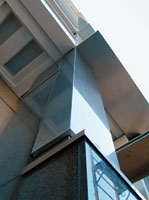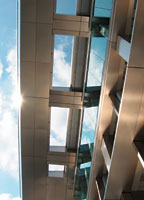Born Again: A New Skin Offers a Fresh Start
Buying time
In October 1995, before WJE and SMBW entered the picture, a temporary solution was implemented in the name of public safety. Five thousand fiberglass straps and corner supports were installed around the envelope to ensure that the marble panels stayed in place. "While the straps prevented shards of marble from falling to the sidewalks below," explains Scribner, "they restrained thermal movement, which caused further bowing of the panels and accelerated the deterioration process." It couldn't have come as a huge surprise that over the years the deterioration continued, and new cracks developed that again raised serious concerns about public-safety issues and called for a genuine architectural solution.
This is why, in September 1997, SMBW and WJE were called to study the situation further and search for a long-term solution. After the forensic part of their study was concluded, the team suggested immediate short-term mitigation for the different areas of the complex to complement the fiberglass-strap treatment. The marble panels in question are of two thicknesses. The tower's fascia and soffit panels are 2 centimeters thick, while the quadrant panels are 3 centimeters. The panels range in size from 6 to 18 square feet, depending on location, and are supported by different types of dead load anchors and "hairpin" anchors, many of which had become disengaged, or at least were observed to be overstressed.
|
|||||
Whereas the study was detailed and comprehensive, only a summary of the final recommendations can be included here. With regard to the quadrants, the study concluded that laboratory-tested marble samples had higher flexural strength, and panel substrates and anchors were in better shape than other areas of the building. It therefore recommended that temporary pinning/stabilization was a viable, short-term solution, with the added recommendation that visual inspections be frequent.
The tower, however, was more vulnerable to failure due to strength loss evidenced by bowing and edge-cracking. Consequently, the pinning/stabilization recommended for the quadrants was not an option. SMBW and WJE insisted that the worst panels be removed immediately. In this instance, they recommended that they be temporarily replaced with a fully anchored exterior-grade plywood or similar weather-resistant material, painted to match existing marble, and sealed to resist moisture penetration. As with the quadrants, the study recommended frequent close-range surveillance.











